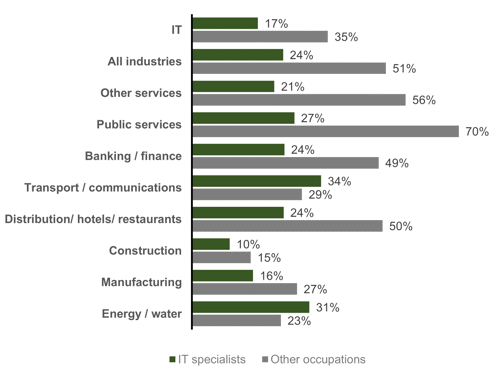Employment characteristics
Self-employment
In 2023, there were 126,000 self-employed IT specialists in the UK, representing 6% of the total IT specialists at that time. The incidence of self-employment amongst female IT specialists however was slightly lower (5%) and well below the level recorded by women in the workforce (9%).
Gender and the incidence of self-employment (2023)

Source: Analysis of ONS Quarterly Labour Force Survey by BCS
Employees and size of workplace
IT specialists working as employees are more likely than others to be employed within larger workplaces (as micro/small sites are less likely to have an in-house function) and whilst 31% of UK employees were working in larger sites (those with 250 or more staff) during 2023, a figure of 42% was recorded for IT specialist employees.
IT specialists by gender and size of workplace (2023)

Source: Analysis of ONS Quarterly Labour Force Survey by BCS
Industry of employment
Overall, almost half (43%) of all IT specialists in the UK in 2023 could be found working in the IT sector though for women the figure was much lower at around one-third (35%).
After IT, the next largest employer of IT specialists (male or female) was banking/finance (27% of female IT specialists and 24% of IT specialists as a whole), and the public sector (18% and 14% respectively).
Looking in more detail at the levels of representation for female IT specialists in different industries in 2023, representation was highest in the transport / communications and energy / water sectors with figures of 34% and 31% respectively.
Conversely, the construction sector had the worst gender balance with regards to IT specialists – and just 10% of IT specialists were women.
Female employees by occupation and industry (2023)

Source: Analysis of ONS Quarterly Labour Force Survey by BCS
* Five-year average








